|
|
Durbar

|
|
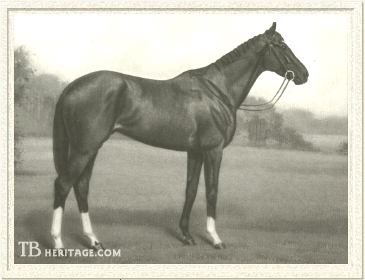 |
|
|
Durbar II was a Derby winner in a less-than-memorable year, but his controversial pedigree made him a landmark case, as the first Derby winner whose pedigree was not recognized by the English Jockey Club as a pure-bred thoroughbred. Despite the controversy, Durbar II proved that his Derby from was not an anomaly and that his pedigree was up to true classic standards. He went on to a solid career at stud, with long-ranging influence in French and American racing.
In the early 1900s, the best racing in the United States was in held in New York State, at tracks like Saratoga, Sheepshead Bay, Gravesend, Brighton Beach, and the newly built Aqueduct and Belmont Park. But bad news was on the wind. In 1908, the state legislature passed the Hart-Agnew bill that outlawed gambling in the state, thus seriously hampering efforts to maintain horse racing there. A few tracks struggled on without betting, but racing entirely shut down in the state from 1911 to 1913, as it did in other states across the country. More and more American owners began to race their stock abroad and many, including August Belmont, H.P. Whitney, and his good friend Herman B. Duryea, sent much of their best stock to trainers and stud farms in Europe.
Duryea established a stud at Haras du Gazon in France, and one of his mares, English-bred Ravello II, produced Sweeper (by Broomstick, by Whitney's great American sire but exported in utero to France), which won the English 2,000 Guineas in 1912. Another Duryea broodmare was the Whitney-bred Armenia, a stakes-winning daughter of imported Meddler out of stakes-winning Urania by Hanover. Urania was a daughter of the champion racemare Wanda, tracing back in tail-female line to an unnamed mare by imported Medley out of an unknown dam. The family is now known as American Family 4 (or A4), but this unknown root mare was just one of Armenia's problems in the eyes of the English Jockey Club.
Although a stakes winner herself from an impeccable female line, the glaring error was that of her grandsire Hanover, one of America's great champions and sires. His own pedigree was a mix of English and American bloodlines, although several of those American roots were of dubious descent, that is, not from "thoroughbred" descent. In 1913, the Jockey Club had passed the notorious Jersey Act, which barred from registration horses which could not trace their pedigrees back flawlessly to the General Stud Book, a matter upheld by Weatherbys', which published the stud book. This, naturally, included many American-breds, especially those carrying the blood of Hanover, despite the fact that his daughter Rhoda B. had already produced two English classic winners in English and Irish Derby winner Orby (foaled in 1904) and 1,000 Guineas winner Rhodora (foaled 1905).
In 1911, Duryea's mare Armenia foaled a bay colt in France by the outstanding sire Rabelais (by St. Simon). Rabelais was bred in England and had raced with success there (National Breeders' Produce Stakes, Prince of Wales's Stakes, Goodwood Cup, third in the 2,000 Guineas, fourth in the Derby).
|
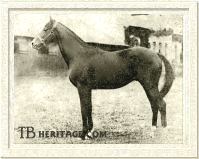
Rabelais | | Originally slated to go to stud in Russia, the deal fell through and instead, Rabelais was sold to enter stud in France in 1905 at Haras de Montfort. His first crop included Grand Prix de Paris winner Verdun, the beginning of an outstanding stud career which led him to Leading Sire titles in 1909, 1919, and 1926. Rabelais also sired Derby winner Durbar II (subject of this essay), Prix de l'Arc de Triomphe winner Biribi, Prix du Jockey Club winner Ramus, Poule d'Essai des Poulains (French 2,000 Guineas) winner Pendennis, Poule d'Essai des Pouliches (French 1,000 Guineas) winners Vellica and Roahouga, as well as champion Rire Aux l'Armes, Rialto, and Havresac II (leading sire in Italy 10 times). | |
Armenia's colt was named Durbar, a Hindu term referring to an audience chamber or reception hall for an Indian prince. He was registered in the French Stud Book as such (he acquired the "II" when racing in England), which had not gone the way of the English in barring American pedigrees as "half-breds." He made 4 starts at 2 without success, but improved each time, running unplaced in his debut, then fourth in the Criterium de Maison Lafitte, and Omnium des Deux Ans, and third in the Prix Prestige in his last trip that season.
Returning at 3, Durbar broke his maiden with an open air two length victory in the Prix de St. Cloud (2,000 meters or 1 1/4 miles), and followed up by defeating Allumeur in the Prix Delatre (2,000 meters) by almost a length. He went down to the outstanding colt Sardanapale (champion of his generation in France) in the Prix Lagrange, with the previous year's juvenile champion Le Grand Pressigny in third. Durbar won again in his next start, the Prix Biennial (2,000 meters), then scored in the Prix Noalles (2,400 meters or 1 1/2 miles) over Le Grand Pressigny. Unable to overcome a bad start in the Poule d'Essai des Poulains, Durbar finished sixth behind winner Listman, and second-place La Farina.
|
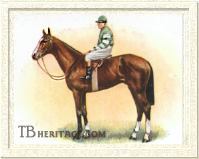
Durbar as Derby winner | |
Since he was only barred from registration in the General Stud Book, not from actually competing in races in England, Duryea sent his good colt to England to contest the Epsom Derby, which had come up light following the premature retirement of the English superstar The Tetrarch. Durbar, now Durbar II, took advantage of a less than distinguished field and romped home by three lengths over Hapsburg and Peter the Hermit in the mile and a half classic. His win marked the first time since Gladiateur in 1865, that a French-bred horse had won this most prized English event, and he was briefly a national hero in his homeland. His win also marked the first time the Derby was won by a horse descending in female line from an American family, A4.
|
This prestige was short-lived when Durbar met Sardanapale in his next start, the Prix du Jockey Club (2,400 meters). Sardanapale won by two lengths, with Durbar coming home in fourth place behind him, Diderot and La Corsaire. Sardanapale whipped him again in the Grand Prix de Paris, with La Farina a head second and Durbar coming in third.
Durbar retired after this race, compiling a record of 5 victories in 13 starts at 2 and 3. He was a flashy bay horse like his sire, with the same three feet white, all but the left fore, although Durbar's stockings were higher than Rabelais' and Durbar also sported a wide blaze. He was a medium-sized horse at 15.3 hands, not considered particularly attractive although Ulbrich notes "he moved with a delightfully smooth action and when racing, it was forgotten that he was not the most eye-pleasing of animals." Photos show him to have a rather short neck and a little light through the barrel, although he appears otherwise well balanced, with long forearms, a good shoulder, good hindquarter and well formed hind leg.
Durbar in the Stud
Durbar entered stud at Haras du Gazon in 1915, and despite being unrecognized as a pure-bred by the Jockey Club and Weatherbys, proved a solid success in France. A few years into Durbar's stud career, Henry Duryea died, and while his widow maintained the stallions (which included Sweeper II, Irish Lad, and Durbar II) and most of the broodmare band, she unloaded some stock. Mrs. Duryea sold the broodmare La Flambee (by Ajax) to American William Woodward, who imported the mare, her 2-year-old filly La Rablee (by Rabelais), and her yearling filly by Durbar II in 1919. |
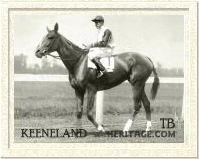
Flambette. Photo courtesy Keeneland Library. Used with permission. | |
The filly, named *Flambette, won the Coaching Club American Oaks at Belmont Park and the Latonia Oaks in 1918. She became an important broodmare for Woodward's Belair Stud, dam of stakes winners Flambino, Flaming, and Cycle. Flambino was the dam of Triple Crown winner Omaha, Ascot Gold Cup winner Flares, and stakes winner Fleam. *Flambette's unraced daughter La France became the dam of champions Jacola and Johnstown. Another daughter, Gallette, produced the champion racemare Gallorette and her sister Gallita, dam herself of champion Nadir, and the important broodmare Gal I Love. This is the family of Belmont Stakes winner Sportin' Life, and G1 winners Folk Art, Meshaallah, Northern Baby, Local Talent, and Canadian champion Bayford. |
In 1919, the remaining yearlings from Duryea's 1918 foal crop were sold to Marcel Boussac, just beginning his great career as a breeder in France. This group included Durbar's daughters Durzetta, out of the American champion mare Frizette, and the closely-related Durban, out of French 1,000 Guineas winner Banshee, by Irish Lad - Frizette. Durzetta was the champion 2-year-old filly in France, while Durban was second only to Durzetta at 2, and the following year won the Prix Vermeille.
|
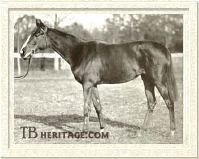
Daughter Durban, dam of Tourbillon and two other top stakes winners
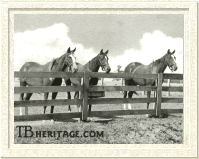
Some Durbar II American fillies at Prospect Hill Farm
| |
Durban became the more important producer, as dam of Banstar (Prix Morny, Prix Eugene Adam, etc.; sire), Diademe (Prix Penelope, Newmarket Oaks), but most importantly, of Tourbillon (1928 by Ksar), winner of the Prix du Jockey Club and a perennial leading sire in France (Leader in 1940, 1942, 1945). Along with AstÈrus and later Pharis, Tourbillon was one of the pillars of Marcel Boussac's breeding empire and a tremendous influence on not just French breeding but also international breeding, as many of his sons went to stud around the globe. His best included Djebel (English 2,000 Guineas, Prix de l'Arc de Triomphe; leading sire in France 4 times), Ambiorix (leading sire in U.S.), classic winners Cillas, Gaspillage, Esmeralda, Coaraze (leading sire in Brazil), Caracalla, and Tourment.
Boussac continued to buy stock from Mrs. Duryea, including the filly Heldifann, a 1921 full sister to Durban, who became a stakes winner and important broodmare for her new owner. Heldifann's daughter Djezima produced champion Priam II, Djeddah (Champion and Eclipse Stakes winner; a good sire in America, dam's sire of Never Bend, Bold Reason, Proud Clarion, Mr. Leader), Flamboyant, and Tourzima. Through the latter, this female line is still strong in Europe today, and has produced the likes of top sire and broodmare sire Darshaan.
|
Other important offspring sired by Durbar while in France included Poule d'Essai des Pouliches winner Rebia, Scaramouche (winner of the Prix de la Foret, and sire himself of Pantalon, sire in Argentina of Talon, a top handicapper when racing in America), stakes winners Durglass, Javelot, Xander, Altay, Larsy, and Cestona, among his 16 French-bred stakes winners.
Besides those already mentioned, Durbar's French-bred daughters included Fantatic, dam of the good runner and sire Fantastic (by Aethelstan II), the imported mare La Muiron, who produced the champion handicap mare Tred Avon (by Sir Greysteel), and Cestona, dam of French Derby and Grand Prix de Paris winner Clairvoyant (by Mon Talisman).
Mrs. Duryea transferred Durbar to America (where he was also known as *Durbar II) following the 1924 season, and he stood at Claiborne Stud in Kentucky until the autumn of 1931. Mrs. Duryea died late in 1928 and the horse became the property of her nephew, Robert H. Heighe. Durbar II, now 20 years old, was then moved to a new farm being built by Mr. and Mrs. Heighe near Bel Air, Maryland. Not long after his arrival, the old stallion became ill and died before he could make the next breeding season. His cause of death was never determined with certainty, but the horse died with colicky symptoms believed to have been caused by moldy hay. He was buried in the lawn in front of the Heighe's house at Prospect Hill Stud.
Durbar's American offspring were not nearly as successful as his European ones. Only two became stakes winners, and minor ones at that, the colts Bathorse and Indian Salute. A daughter, Maridel, produced the champion steeplechaser Brother Jones (by Petee-Wrack), but none of his American-bred daughters left the same kind of impact, or had the same opportunity for that matter, as those he sired in France.
Durbar II, Derby winner and influential sire, whose bloodlines changed the course of thoroughbred breeding in France and America, will be honored in the near future with an historical marker on the campus of the Harford Community College, built on the site of Prospect Hill Stud, where he lies buried.
--Anne Peters |
|
|
|

